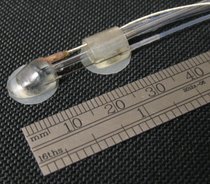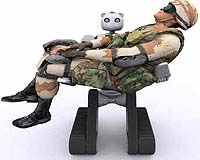 Researchers behind the Army's top 10 greatest inventions for 2006 were recognized recently at a ceremony in Arlington, Virginia. The Army's Greatest Inventions for 2006 are:Blow Torch Counter Improvised Explosive Device System, U.S. Army Research Laboratory
Researchers behind the Army's top 10 greatest inventions for 2006 were recognized recently at a ceremony in Arlington, Virginia. The Army's Greatest Inventions for 2006 are:Blow Torch Counter Improvised Explosive Device System, U.S. Army Research Laboratory, Aberdeen Proving Ground, Md. This vehicle-mounted system detonates IEDs at safe stand-off distances, minimizing vehicle damage and Soldier injuries.
"It's fairly easy to operate, and it gives a sense of security to the Soldiers when they're on convoy duty," said Maj. Brian Hackenberg, who helped develop the system.
Integrated Robotic Explosive Detection System, U.S. Army Aviation and Missile Research, Development and Engineering Center, Redstone Arsenal, Ala. Capable of crossing rugged terrain, this remotely operated system incorporates an explosive trace detector onto a robotic platform.
Plastic Shaped Charge Assembly for Remote Destruction of Buried IEDs, U.S. Army Armament Research, Development and Engineering Center, Picatinny Arsenal, N.J. Remotely emplaced, the PSCA destroys known or suspected unexploded ordnance with higher accuracy than similar devices currently in use. Its low-fragmentation plastic housing eliminates collateral damage.
Humvee Crew Extraction D-ring, U.S. Army Aviation and Missile Research, Development and Engineering Center, Redstone Arsenal, Ala. Combat locks on the up-armored Humvee provide security for Soldiers but often get so damaged the doors can't be opened. The D-ring provides solid anchor points for the hooks of a tow strap, chain or cable to pull open damaged doors.
"There was an issue of Soldiers getting trapped inside Humvees that had been damaged for whatever reason ... enemy fire or being flipped. Soldiers had problems getting the doors off these up-armored Humvees so we took their advice and created the D-ring," said Wesley D. Patterson, who is part of a Fast Assistance in Sciences Team that deploys to help Soldiers solve problems that can be resolved within six months.
M1114 Humvee Interim Fragment Kit 5, U.S. Army Research Laboratory, Aberdeen Proving Ground, Md. This kit was fielded as a ballistic improvement for the M1114 Humvee in April 2006. A prototype door solution with fabrication and mounting instructions was provided within one week with automotive testing and safety certification.
Remote Urban Monitoring System, U.S. Army Communications-Electronics Research, Development and Engineering Center, Fort Belvoir, Va. RUMS hardware combines emerging technologies in Wireless Local Area Network technology, night-vision cameras and unattended ground sensors to eliminate false alarms. Tripped sensors transmit an alarm signal to the camera module and operator after video and audio from multiple camera modules confirm the unattended ground sensor's alarm signal.
Constant Hawk, U.S. Army Research Laboratory, Aberdeen Proving Ground, Md. Constant Hawk is a surveillance capability that uses an electro-optic payload to collect intelligence and identify areas that require increased surveillance by other assets.
OmniSense Unattended Ground Sensor System,
U.S. Army Research Laboratory, Aberdeen Proving Ground, Md. OmniSense is an unattended ground sensor system used to detect and classify personnel and vehicles in perimeter defense.
EM113A2 Rapid Entry Vehicle,
U.S. Army Armament Research, Development and Engineering Center, Picatinny, N.J. The REV provides rapid entry, non-lethal crowd control and rescue-squad insertion capabilities into areas requiring non-lethal intervention. The vehicle increases Soldier survivability through improved situational awareness and the ability to move and fire from within an armored vehicle.
BuckEye System,
U.S. Army Engineer Research and Development Center, Vicksburg, Miss. BuckEye uses a digital camera to produce geospatial information for intelligence, surveillance and reconnaissance. It also produces high-resolution 3D urban mapping.
Chief Warrant Officer 4 Michael Harper said the BuckEye System has been instrumental in allowing a maneuver commander to rapidly map battle space through high-resolution imagery and to collect elevation data to give a 3D view.
"What it gives to Soldiers is added situational awareness they need to fight in an urban terrain," he said. "BuckEye has essentially mapped almost every major city in Iraq thus far."
 Using nanotechnology and MEMS technology in energy harvesting applications is a work in progress that nevertheless shows huge potential, experts said.
Using nanotechnology and MEMS technology in energy harvesting applications is a work in progress that nevertheless shows huge potential, experts said.









































